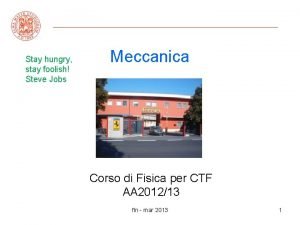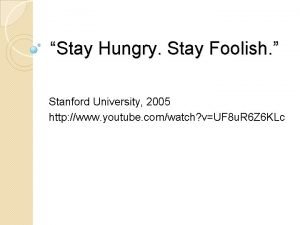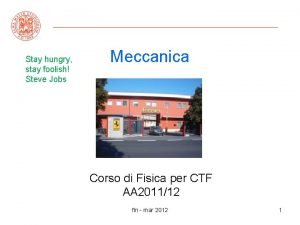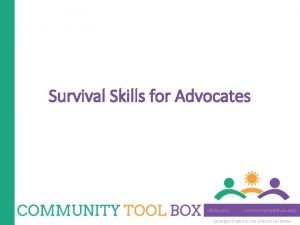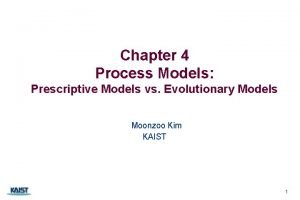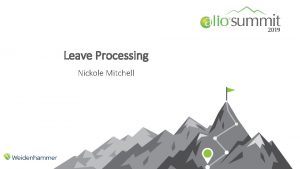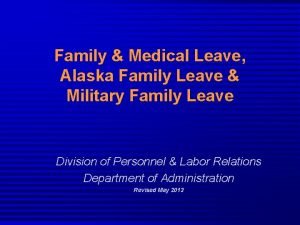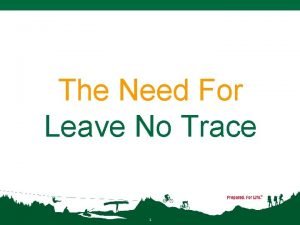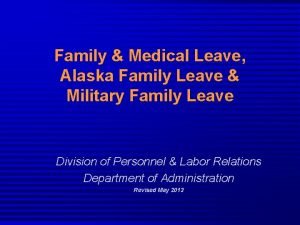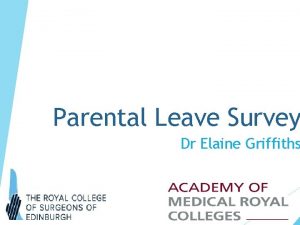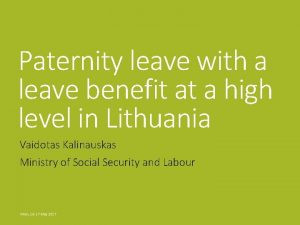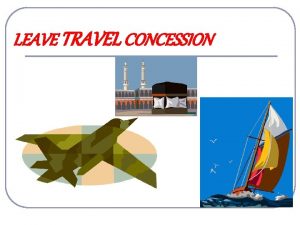Decisions to leave decisions to stay Advocates use



















- Slides: 19

Decisions to leave, decisions to stay: Advocates’ use of discourses of violence and trauma in explaining the behaviour of “trafficked people” Siân Oram

About the Research • • • Qualitative case study of how the health needs of trafficked people have been considered within the UK response to trafficking Period of interest: 2000 -2010 3 methods of data collection: – Semi Structured Interviews • Post trafficking service providers (7); NGO advocates (10); Enforcement officials (7); Healthcare Providers (7); Lawyers (5); Civil servants (7)* – Participant Observation • e. g. , at the Joint NGO Ministerial Stakeholder Group, UK Border Agency review workshops; UK Human Trafficking Centre briefing days; All Party Parliamentary Group on Human Trafficking meetings; Department of Health VAW working groups; NGO events; Conferences, round tables, seminars; – Document analysis • National Action Plan and associated documents; Government inquiries and associated documents; Parliamentary debates; Meeting minutes and agendas; • Data analysed using framework analysis in NVivo and Microsoft Excel * No interviews were conducted with trafficked women

Background • Over the last decade, the UK has begun to respond to human trafficking as a policy problem(Home Office 2002, 2006, 2007) • The policing of trafficking has increased through the establishment of specialist police teams, training programmes, and specific anti-trafficking operations. • Support services for women who had been trafficked for sexual exploitation were established in 2003. The government currently funds support in London, Sheffield and Cardiff through the Poppy Project. • It has been noted that women whom the police/service providers believe to be trafficked may refuse assistance or break contact and return to sex work (Avenall, 2007).

Objectives 1. To show trafficking for sexual exploitation is generally understood to be extremely violent and traumatising 2. To demonstrate how NGOs, service providers and lawyers involved in the response to trafficking have suggested that women’s experiences of violence and trauma explain why they do not leave the trafficking situation. 3. To suggest reasons for why these arguments may have been employed

Trafficking as violent & traumatising “Trafficking victims suffer severe physical, psychological, and emotional health consequences as they are subjected to a range of abuse that may include physical violence, sexual assault, emotional abuse, mind control and torture” (Poppy Project response to the UK Action Plan on Human Trafficking consultation)

Sexual and physical violence • Sexual violence featured prominently in discussions on TSE – Rape was presented as an integral part of the dynamics of trafficking for sexual exploitation – NGO advocates, service providers, parliamentarians, enforcement officials, and healthcare providers reported that women were “systematically raped” by traffickers and that clients’ sex with trafficked women was “equivalent to multiple rape”. • Physical violence was discussed less frequently, but was consistently reported by two of the key NGOs – Amnesty International UK and Poppy Project policy documents reported that women were physically abused by traffickers. – They reported that physical abuse was used to maintain control over women, force them into sex work, for confiding in clients about their situation, and to punish women for not earning enough money. – Traffickers’ threats of further violence to women and to their families were also reported.

Physical and Mental Health • When specifically asked to talk about the health needs of trafficked people during interviews, participants tended to speak about health issues arising as a consequence of violence and abuse. – Physical injuries – Sexually transmitted infections, unwanted pregnancy, injury to reproductive tract – Mental health, particularly trauma/posttraumatic stress disorder • Analysis found that NGO advocates, service providers, and lawyers tended to suggest that all women who had been trafficked for sexual exploitation were, to varying degrees, traumatised as a result of having been trafficked • The Poppy Project and Amnesty International UK drew on a study of health outcomes amongst trafficked women (“Stolen Smiles”) to report that the manifestations of trauma in trafficked women included headaches, chronic fear, anxiety, sleep disorders, chronic fatigue, delusions, and memory loss

Alternative views… • Analysis of interview data found that enforcement officials and healthcare providers gave a more nuanced view • This group of interviewees emphasised the variation in women’s experiences and their subsequent physical and psychological health. I have to say the health needs are quite general. Nothing specific would stand out for anyone who has been trafficked. (Healthcare Provider) The women do vary a lot. Some are much more passive and compliant. I’ve seen some who are really quite kind of feisty …[others are] very beaten down. (Healthcare Provider) There’s some people who have this romanticised view that all victims of trafficking are at the extreme, the far extreme…It happens [but] we also work with a lot who aren’t quite as clear as that (Enforcement)

Stakeholders’ explanations for why women do not leave the trafficking situation

Fear of future harm • Service providers, NGO advocates, and enforcement officials suggested that women’s fear of further violence meant they may be scared to “escape” from their traffickers or may decide to return to them after “rescue”. • Legitimised by the construction of traffickers as part of sophisticated organised crime networks • Also legitimised by studies and anecdotal reports detailing how women experienced violence whilst trafficked and threats of further harm Identifying victims arose as a major problem…due to women’s reluctance to talk…a woman would be less likely to speak at the scene for several reasons, for example, she is probably being watched; speaking to officers may endanger her life and the lives of family members. (Op Pentameter 1 Review) They are threatened, they fear for their families… some of them choose to go back to prostitution. Women will say I’m here with free will and I’m fine…[but] of course they are trafficked (Service Provider)

Lack of control • Traffickers’ control over women meant that women may be physically or psychologically unable to leave • NGOs, service providers, advocates, and some enforcement officials and healthcare providers spoke about how women had restrictions placed on their freedom of movement; were denied contact with other people; had no access to their earnings or possessions. • Although some interviewees spoke about women being physically restrained, most emphasised traffickers’ use of psychological control tactics Certainly our experience is of women who can’t sleep in their own bedroom because they’ve been locked in a cellar for 6 months and brought up and raped 12 times a night and locked back down (Service Provider) T Traffickers …create a complex web of control through debt bondage, psychological violence and threats… to put their victims into a situation of total dependence, where victims are scared or too intimidated to escape or reveal what happened to them. (NGO report)

Ongoing trauma • NGO advocates, service providers, and lawyers suggested that women’s “cognitive functioning” could be reduced to the extent that they could not make informed decisions about their safety or future. • One trauma counsellor stated that trauma was integral to understanding why trafficked women returned to sex work. • It was generally used, however, to explain why women may not disclose their experiences. A continuing bond with the trafficker, continuing in sex work? If you don’t understand the nature of trauma, then you cannot understand the actions of people who are traumatised. (Healthcare Provider) Victims of trafficking may be unwilling to disclose that they have been trafficked because they fear retribution from traffickers or are too traumatised by the experience (Poppy Project, Home Affairs Committee Report)

Other views… • A minority of interviewees placed greater emphasis on women’s reluctance to leave/decisions to return being due to women: – being in relationships with their traffickers – needing to continue to earn money in order to pay off a debt bond or to support their families at home – believing that they would be arrested and/or deported by the UK authorities Genuine relationships exist within the trafficking context. Not relationships that maybe you or I would want, you know, it can all be quite, quite odd. But, the woman is saying this is my choice, we’re going to get married, I love him. (Healthcare) Anti-traffickers never tell you about the times when immigration and the police come in, rescue trafficked women and the women go “I don’t want to be rescued”. And guess what happens? They get deported. (Healthcare)

Why have these arguments been used? • Bias in the knowledge base? • Establishing credibility? • To support calls for the provision of post-trafficking protection and assistance?

Bias • A number of academics have questioned the representativeness of extremely violent narratives and imagery in anti-trafficking work (Aradau 2004; Saunders 2005; O'Connell-Davidson 2006; Andrijasevic 2007; Brunovskis and Surtees 2010) • The “knowledge base” draws heavily upon the experiences of police officers and NGOs, and the academic research that has been conducted is heavily reliant upon the testimony / survey responses of NGO service users (Kelly 2005, Tyldum 2005) • Research has found that there are systematic differences between victims who accepted and declined assistance (Brunovskis and Surtees 2007) • The stories of women who are not in such urgent need of support, who feel that they do not need support, or who will not accept it on the terms offered, are therefore lost. • Furthermore, the research found that services who may be working with these women, such as sexual health outreach services, are absent from the UK trafficking policymaking process.

Credibility • Women’s credibility as “victims of trafficking” could be negatively affected because women did not claim asylum when they first had chance to do so and were believed to be “not generally credible”(UKBA 2010) – “The Secretary Of State […] notes that you only claimed asylum on 15 th March 2002 after you had worked illegally as a prostitute in the United Kingdom. By making your application for asylum after several months without a valid believable reason for not claiming on arrival, you have failed to do so. He concludes that you have fabricated your basis of claim in an attempt to prevent your removal from, and remain in, the UK, and that your application is an abuse of the UK’s asylum provision. ” • The research found that advocates, service providers and lawyers drew on these arguments to help overcome negative credibility decisions in the immigration process and criminal justice system.

Support and Protection • Experiences of violence and harm seemed to function as indicators that a person had not consented to work in the sex industry: – I am glad to say that the girl was absolutely appalled by what she was asked to do. I think that she was raped at least eight or nine times on the first night that she was there. (Steen, Debate February 2009) • Harm and non-consent were important components of NGO arguments that the government should provide support and protection to trafficked people. • Munro’s analyses of the UK response to trafficking have also suggested that non-consent is important for trafficked people’s access to support and protection (Munro 2005, Munro 2006) • Aradau has suggested that “discourses of suffering” function to transform trafficked people from criminals (i. e. , illegal immigrants, prostitutes) into objects of pity (Aradau 2004)

Summary • • • Analysis of policy documents showed that trafficking for sexual exploitation was generally constructed as an issue that was extremely violent and which had serious consequences for the physical and mental health of trafficked people. During interviews, a number of enforcement officials and healthcare practitioners questioned whether this was a representative image. NGOs, service providers, lawyers, and some healthcare providers drew on ideas about violence, control, and trauma to explain why women did not leave their traffickers or why, having left, they later returned. A minority of interviewees suggested that women made legitimate decisions to stay that were not rooted in fear or trauma. Further questions: • • Are the experiences of extreme violence and trauma common enough to warrant the types of programmes and policies that have been developed to respond to trafficking? Are the services that have been developed (and the use of eligibility criteria such as having exited sex work) suitable for meeting the needs of trafficked people?

References • • • • Andrijasevic, R. (2007). "Beautiful dead bodies: gender, migration and representation in anti-trafficking campaigns. " Feminist Review 86: 24 -44. Aradau, C. (2004). "The perverse politics of four-letter words: risk and pity in the securitisation of human trafficking. " Millenium: Journal of International Studies 33(2): 251 -277. Avenall, J. (2007). Trafficking for sexual exploitation: a process review of Operation Pentameter 1 (full report). . London, RDS, Home Office. Brunovskis, A. and R. Surtees (2007). Leaving the Past Behind? When Victims of Trafficking Decline Assistance. , Fafo. Brunovskis, A. and R. Surtees (2010). "Untold Stories: Biases and Selection Effects in Research with Victims of Trafficking for Sexual Exploitation. " International Migration 48(4): 1 -37. Home. Office (2002). Secure Borders, Safe Haven: Integration with Diversity in Modern Britain. London, TSO. Home. Office (2006). Tackling Human Trafficking - Consultation on Proposals for a UK Action Plan. London, TSO. Home. Office (2007). UK Action Plan on Tackling Human Trafficking. London, TSO. Kelly, L. (2005). "“You Can Find Anything You Want”: A Critical Reflection on Research on Trafficking in Persons within and into Europe. " International Migration 43(1 -2): 235 -265. Munro, V. E. (2005). "A tale of two servitudes: defining and implementing a domestic response to trafficking of women for prostitution in the UK and Australia. " Social Legal Studies 14: 91 -114. Munro, V. E. (2006). "Stopping traffic? A comparative study of responses to the trafficking in women for prostitution. " British Journal of Criminology 46(2): 318 -333. O'Connell-Davidson, J. (2006). "Will the real sex slave please stand up? . " Feminist Review 83: 4 -22. Saunders, P. (2005). "Traffic Violations: Determining the Meaning of Violence in Sexual Trafficking Versus Sex Work. " Journal of Interpersonal Violence 20(3): 343 -360. Tyldum, G. (2010). "Limitations in Research on Human Trafficking*. " International Migration 48(5): 1 -13. UKBA (2010). Asylum Process Guidance: Assessing Credibility in Asylum and Human Rights Claims. UKBA. London.
 Good decision making poster
Good decision making poster Good afternoon stay healthy
Good afternoon stay healthy Good morning stay home stay safe images
Good morning stay home stay safe images Where you go i'll go where you stay ill stay
Where you go i'll go where you stay ill stay So stay so stay 再知己
So stay so stay 再知己 Stay hungry stay foolish significato
Stay hungry stay foolish significato Stay tuned stay foolish
Stay tuned stay foolish To daffodils analysis robert herrick
To daffodils analysis robert herrick I hope the days come easy
I hope the days come easy Stay hungry stay foolish significato
Stay hungry stay foolish significato Khurana & khurana advocates and ip attorneys (delhi branch)
Khurana & khurana advocates and ip attorneys (delhi branch) Housing land advocates
Housing land advocates Khurana & khurana advocates and ip attorneys
Khurana & khurana advocates and ip attorneys Early ob advocates
Early ob advocates Survival skills for advocates
Survival skills for advocates Diane gould advocates
Diane gould advocates Difference between prescriptive and evolutionary model
Difference between prescriptive and evolutionary model Screening decisions and preference decisions
Screening decisions and preference decisions Walmart pto accrual rates 2021
Walmart pto accrual rates 2021 How would you use arithmetic sequence in making decisions
How would you use arithmetic sequence in making decisions





